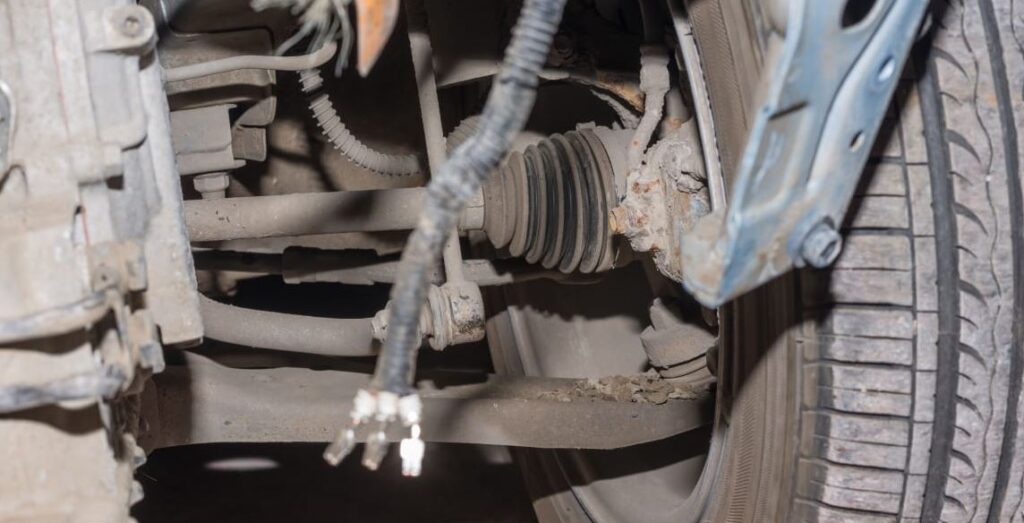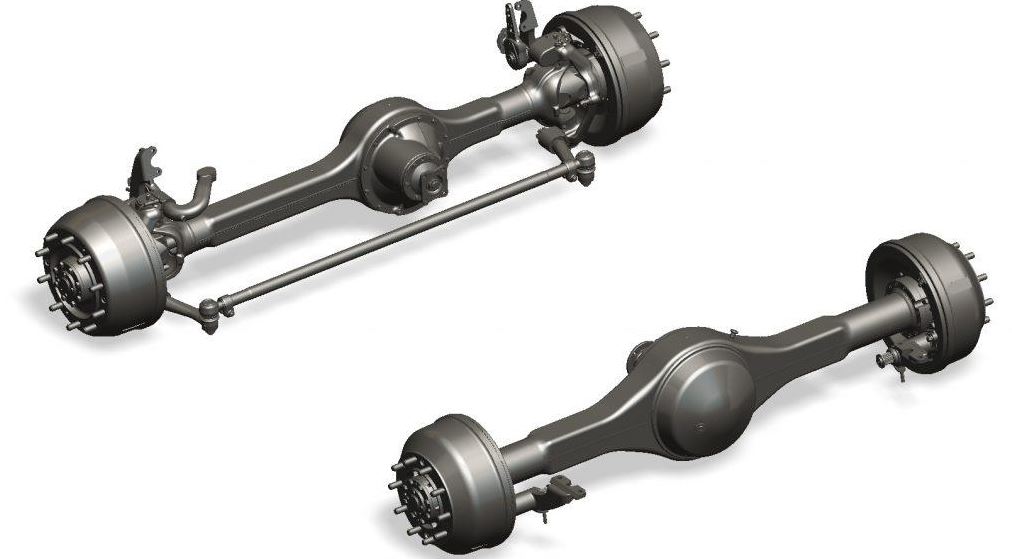Last updated on March 31st, 2023 at 03:58 pm
Hi, welcome to this guide on how to do a Burnout in Automatic cars and Manual Vehicles. With my years of working as an auto part technician, I’ve had the chance to test and perfect various driving techniques. One of my favourites is performing a burnout in both automatic and manual car. This simply translates to a situation where you intentionally cause your tires to lose traction and have them spin rapidly or very fast, creating smoke and an exhilarating sound.
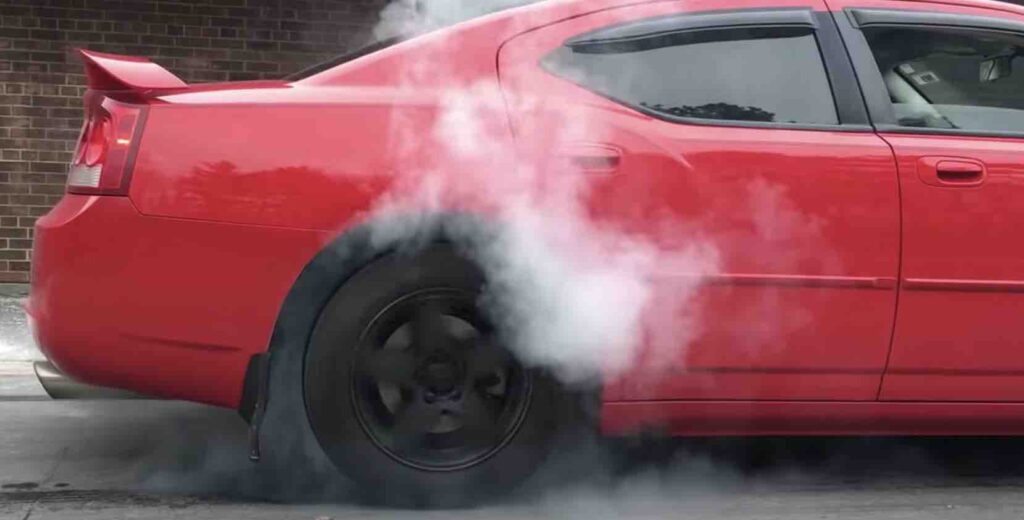
In this article, I’ll guide you through each step required for performing burnout in both automatic and manual vehicles.
Starting from how to do a burnout in an automatic car to help you understand the different techniques for burnout.
The additional topics we will be considering in this article include the following:
How to do a burnout in an automatic, How to do a burnout in a manual, How to burnout a car, How to do burnout in automatic truck, How to do burnout in automatic fwd, How to do a burnout in an automatic rwd car,
How to do a burnout in an automatic 4wd, How to do a burnout in an manual, How to do a burnout in an automatic mustang, Is it bad to do a burnout in an automatic, How to do a burnout in an automatic Camaro, How to do a burnout in a manual, How to do a burnout in an automatic fwd and how to do burnout in automatic rwd.
So, buckle up and get ready to discover the ins and outs of performing a burnout, ensuring you’re well-equipped to impress your fellow car aficionados with your newfound skills. Let’s dive in and explore the exciting world of burnouts in automatic and manual vehicles!
Let’s begin with what is burnout in automatic and manual cars.
What is burnout in an Automatic and manual car
Burnout is a driving maneuvering used in both automatic and manual vehicles, in which the driver intentionally spins their wheels to lose traction and create a cloud of smoke from friction between tires and road surface. This maneuver may be done as an act of power or skill or for entertainment purposes such as car shows, drag races, or other motorsport events.
Burnout automatic car
In an automatic car, burnout is performed by holding down the brake pedal while applying the throttle to increase engine power output. This causes the driven wheels to spin while remaining stationary, leading to a burnout.
Burnout Manual car
Manual cars achieve a burnout by engaging the clutch, revving the engine to build power, and then rapidly releasing it while keeping the brakes engaged. This causes the driven wheels to spin in an automatic car’s similar fashion.
It is essential to be aware that performing burnouts can put undue strain on your vehicle’s tires, transmission, and other components. Therefore, this activity should only be undertaken under controlled circumstances with adequate safety protocols in place.
Now let’s move on to how to perform a burnout in an automatic car
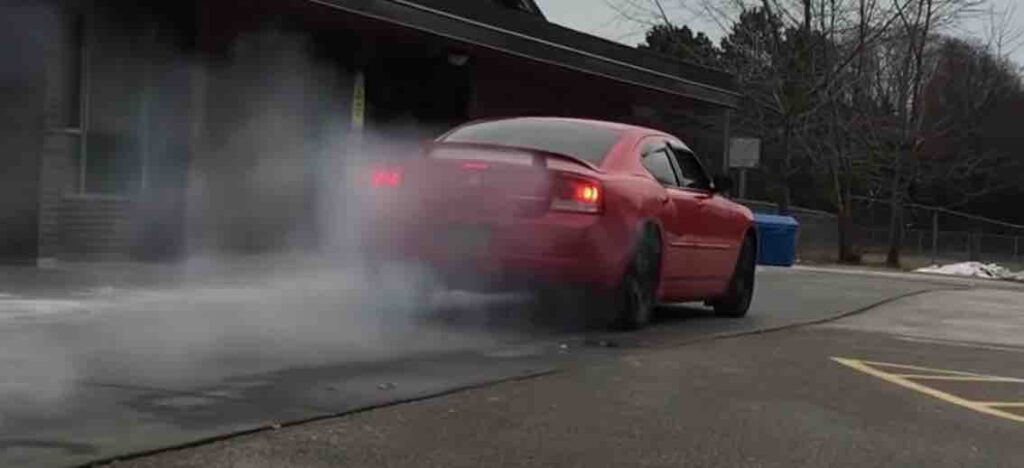
How to do a Burnout in an automatic Car/ Vehicle
So how can you do a burnout in an automatic car? Well, the thing is, performing a burnouts in an automatic car requires slightly different techniques than in manual vehicles, so here is my step-by-step guide on how to do a burnout in an automatic vehicle:
- Step 1: First, you have to start by Locating a safe and legal location to perform your burnout. Ensure the area is free from pedestrians, traffic, and any form of obstacles.
- Step 2: Disable any traction control or stability systems in your car that could interfere with burnout by applying brakes or cutting engine power.
- Step 3: Place your left foot firmly on the brake pedal, applying firm pressure to keep the car stationary.
- Step 4: Engage Drive (D) or, if available, the lowest gear setting for optimal torque output.
- Step 5: With your right foot, gradually increase the gas pedal while maintaining pressure on the brake pedal. As the engine revs, your tires will begin to lose traction and spin, creating a burnout effect.
- Step 6: Limit the burnout by modulating your accelerator and brake pressure. Avoid applying too much throttle as this could damage your transmission.
- Step 7: Once you’re ready to stop the burnout, release the gas pedal and gradually ease off of the brake pedal. Shift into Park (P) or Neutral (N), allowing the tires to cool.
Lets now move on to how to do a burnout in a manual car
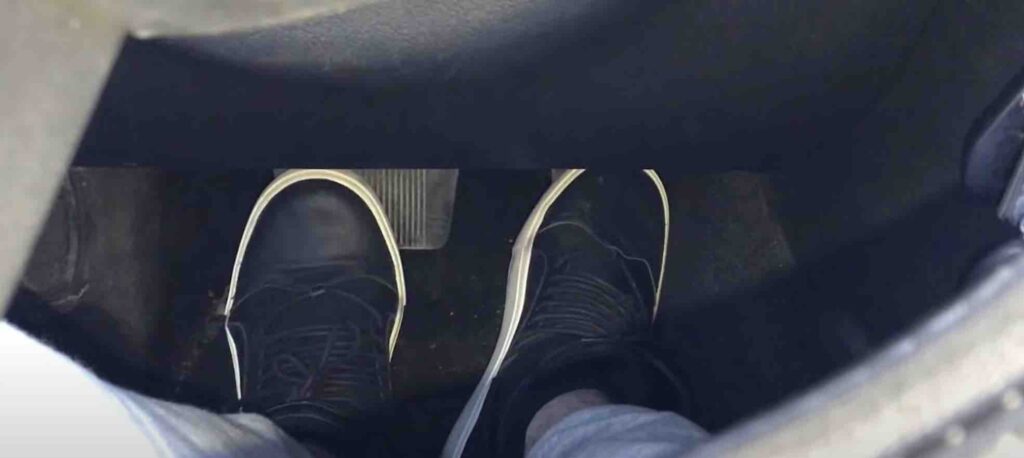
How to Perform a Burnout in a Manual Vehicle
So, how can you perform a burnout in a manual car? Conducting a burnout in a manual vehicle requires more precision but also provides greater control. Here are the steps:
- Step 1: Choose an area suitable and legal for your burnout, free from pedestrians, traffic, and obstructions.
- Step 2: Disable any traction control or stability systems in your car to prevent interference.
- Step 3: Press the clutch pedal with your left foot and shift into first gear.
- Step 4: With your right foot, press down on the brake pedal firmly to keep the car stationary.
- Step 5: Begin to rev the engine by pressing down on the gas pedal with your right foot, aiming for a high RPM.
- Step 6: Quickly release the clutch pedal while maintaining pressure on both brake and gas pedals. Your tires will begin spinning, creating a burnout effect.
- Step 7: Manage the burnout by modulating your accelerator and brake pressure accordingly. Be mindful of your engine’s RPM to avoid over-revving and potential damage.
- Step 8: To conclude the burnout, release the gas pedal, press the clutch, and release the brake pedal. Shift into neutral and let the tires cool off. This is basically how to do a burnout in a manual car.
Now on a general note, the 2 guides above are there about how to burn out a car, whether it is an automatic car or a manual vehicle of any kind, but how about how to do burnout in automatic truck? Are they the same? Well, the steps are similar, with just a slight difference.
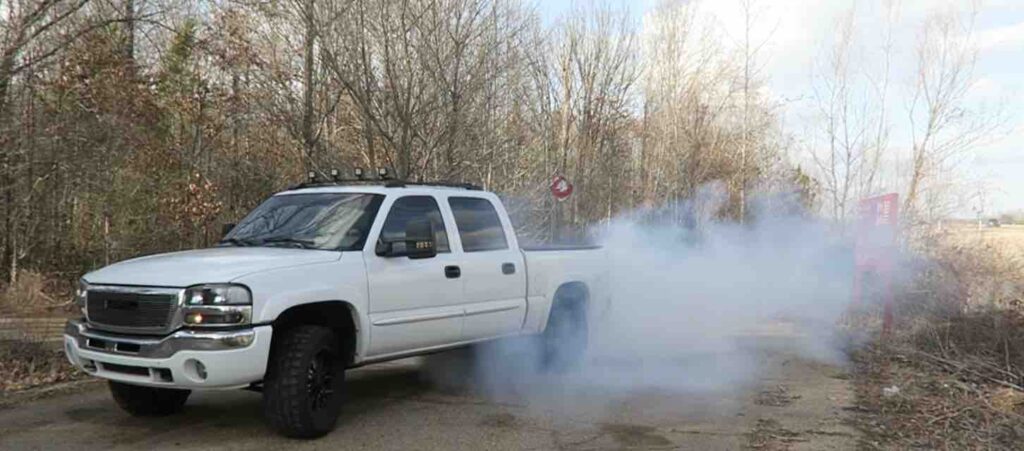
how to do burnout in automatic truck
Burning out in an automatic truck is similar to performing one in a car. Simply follow these steps:
- Step 1: Choose a secure, legal location for your burnout that’s free from pedestrians, traffic and obstructions.
- Step 2: Disable any traction control or stability systems in your truck to avoid interference.
- Step 3: Press and maintain the brake pedal with your left foot, applying firm pressure to keep the truck stationary.
- Step 4: Shift the transmission into Drive (D), or, if available, use the lowest gear setting for improved torque.
- Step 5: With your right foot, gradually press on the gas pedal while maintaining pressure on the brake pedal. As the engine revs, tires will begin to lose traction and spin, creating a burnout effect.
- Step 6: Manage your burnout by modulating gas pedal and brake pressure accordingly. Avoid applying excessive throttle as this could damage your transmission.
- Step 7: Once you’re ready to end the burnout, release the gas pedal and gradually lift off the brake pedal. Shift into Park (P) or Neutral (N), allowing your tires to cool.
So if you are looking for how to do burnout in an automatic rwd or fwd car and the following vehicles, then keep reading.
- automatic mustang
- automatic camaro
- automatic 4wd
So here are Unique Considerations for Different Vehicles when you want to consider performing a burnout on them.
Different Vehicles Require Special Considerations
Automatic FWD (Front-Wheel Drive):
When performing a burnout in an FWD vehicle, be aware that the front tires, which control steering, will be spinning. This could restrict control and increase the risk of an accident. To safely perform such maneuvers in an automatic vehicle, follow these steps for manual vehicles and exercise caution.
Cars With Automatic RWD (Rear-Wheel Drive) and 4WD (Four-Wheel Drive):
RWD and 4WD vehicles may require slightly different techniques when performing a burnout than an automatic vehicle; however, the overall process remains consistent regardless of vehicle type. Be sure to consider your specific car’s unique characteristics when adapting the technique accordingly.
Manual Vehicles:
As previously discussed, the process for performing a burnout on manual vehicles such as Mustangs, Camaros, and others is covered in subheading 3.
Automatic vs. Manual Burnouts: Pros and Cons
When deciding whether or not to perform a burnout in an automatic or manual vehicle, weigh the advantages and potential drawbacks:
how to do a burnout in an automatic rwd car
Automatic Burnouts procs and cons:
Pros:
- Easy to learn and execute for beginners.
- Reduced risk of engine stalling during the process.
Cons:
Minimizing control over vehicle performance and burnout intensity; vulnerability to transmission damage due to increased heat and stress from manual burnouts.
Manual Burnouts Pros and cons:
Pros
- The benefits or pros a Manual Burnouts Offers to include improved control, lessened burnout intensity, and potential transmission damage caused by increased heat and stress levels.
- And if you are a more experienced driver, you will enjoy greater control of the vehicle and burnout intensity, which is more satisfying and engaging for them.
Cons:
- More challenging to learn and execute, especially for beginners.
- You run the risk of stalling the engine or damaging your car clutch.
How to Perform a Burnout on a Motorcycle
A motorcycle burnout requires different technique; here are the steps:
- Step 1: Locate a secure, legal location for the burnout, making sure the area is clear of pedestrians, traffic, and obstacles.
- Step 2: Make sure your motorcycle is in a stable position. Sit on the bike, grasping its handlebars securely, and place both feet firmly on the ground.
- Step 3: Hold the front brake lever with your right hand to keep the motorcycle stationary.
- Step 4: With your left hand, pull in the clutch lever and shift into first gear.
- Step 5: With your right hand, gradually apply the throttle, increasing engine RPMs.
- Step 6: Quickly release the clutch lever while maintaining pressure on both the front brake and throttle. Your rear tire will begin spinning, creating a burnout effect.
- Step 7: Manage the burnout by modulating the throttle. Be mindful of your engine’s RPM to avoid over-revving and potential damage.
- Step 8: To conclude the burnout, release the throttle, pull in the clutch, and allow your rear tire to cool.
Is it Bad to Perform a Burnout in an Automatic?
Burning out in an automatic vehicle puts additional strain on its transmission and other components. Excess heat generated during a burnout can damage components such as torque converters and brakes; however, if performed occasionally and taken necessary precautions, such as allowing the vehicle to cool down afterward, your risk for damage is minimized considerably. Moreover, remember that burnouts also cause excessive tire wear, which should be done responsibly and legally.
Conclusion
Burnouts can be an exhilarating experience for automotive enthusiasts, whether driving an automatic or manual vehicle. The key to successfully executing a burnout lies in understanding your vehicle’s characteristics, using proper technique, and practicing in a secure and legal environment. Remember that burnouts are hard on vehicles and tires, so always prioritize safety when performing one.
In this post, I have shown you how to do a burnout in an automatic and how to do a burnout in a manual.
This is basically how to burnout a car on a general note, and for specific vehicles, it’s the same but may require Special Considerations, which I covered above.
We also looked at how to do a burnout on a motorcycle and how to do burnout in automatic truck.

Uchenna is a Radiographer and Auto parts mechanic who recently got his automotive diploma as an auto repair technician, and since then, has worked on fixing various car problems.
Working as just a radiographer, Uchenna didn’t just get all the fulfillment he desired, because he truly loved doing things tilted toward cars. As a kid, he would take apart his toy cars to see how they worked and would spend hours tinkering with his bike.
So, in 2017 he made the tough decision to become an auto mechanic. He threw himself into his studies and now loves every aspect of what he does.
He gets to work with his hands, solving problems and bringing cars back to life, and sharing his knowledge and easy quick-fix guide online are all part of what makes him feel fulfilled.

